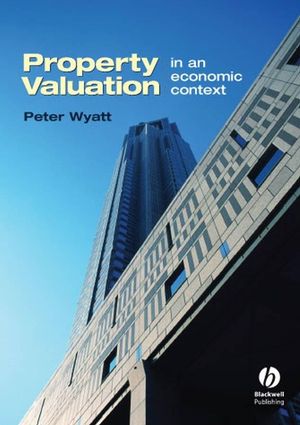Property Valuation: In an Economic ContextISBN: 978-1-4051-3045-5
Paperback
424 pages
November 2007, Wiley-Blackwell
 This title is out-of-print and not currently available for purchase from this site.
|
1 The economics of property value.
1.1 Introduction.
1.2 Microeconomic concepts.
1.2.1 Supply and demand, markets and equilibrium price determination.
1.2.2 The property market and price determination.
1.2.3 Location and land use.
1.3 Macroeconomic concepts.
1.3.1 The commercial property market.
1.3.2 Property occupation.
1.3.3 Property investment.
1.3.4 Property development.
1.3.5 Macroeconomic cycles.
Appendix 1A Measuring property investment performance.
2 Property valuation principles.
2.1 Introduction.
2.2 What is valuation?.
2.2.1 The need for valuations.
2.2.2 Types of properties that need to be valued.
2.2.3 Bases of value.
2.3 Determinants of value.
2.3.1 Property-specific factors.
2.3.2 Market-related factors.
2.4 Valuation mathematics.
2.4.1 The time value of money.
2.4.2 Yields and rates of return.
2.5 Valuation process.
2.5.1 Specific valuation standards.
2.5.2 Measurement.
Appendix 2A Inspection checklist.
Appendix 2B Specimen report for the valuation of an office.
3 Property valuation methods.
3.1 Introduction.
3.2 Comparison method.
3.2.1 Sources of data.
3.2.2 Units of comparison.
3.2.3 Comparison adjustment.
3.3 Investment method.
3.3.1 Valuation of rack-rented freehold property investments.
3.3.2 Valuation of reversionary freehold property investments.
3.3.3 Valuation of leasehold property investments.
3.3.4 Investment method case study – valuation of an edge-of-town office building.
3.4 Profits method.
3.5 Residual method.
3.6 Replacement cost method.
3.7 Summary.
Appendix 3A Alternative methods of calculating an equivalent yield.
4 Property occupation valuation.
4.1 Introduction.
4.2 Rental valuations at lease commencement and at rent reviews.
4.2.1 Rent-free periods.
4.2.2 Premiums and reverse premiums.
4.2.3 Capital contributions.
4.2.4 Stepped rents.
4.2.5 Short leases and leases with break options.
4.2.6 Turnover rents.
4.3 Valuations at lease end or lease renewal.
4.3.1 Landlord and tenant legislation valuations.
4.3.2 Surrender and renewal of leases.
4.4 Capital valuations for financial reporting.
4.4.1 International financial reporting standards.
4.4.2 UK financial reporting standards.
4.4.3 Methods of valuing property assets for financial reporting purposes.
4.5 Valuations for loan security.
4.6 Valuations for tax purposes.
4.6.1 Capital gains tax.
4.6.2 Inheritance tax.
4.6.3 Business rates.
4.7 Valuations for compulsory purchase and compensation.
4.7.1 Compensation for land taken.
4.7.2 Severance and injurious affection.
4.7.3 Disturbance compensation.
4.7.4 Planning compensation.
4.7.5 A note on CGT and compensation for compulsory acquisition.
4.8 Valuation of contaminated land.
5 Property investment valuation.
5.1 Introduction.
5.2 A discounted cash-flow (DCF) valuation model.
5.2.1 Constructing a DCF valuation model.
5.2.2 Key variables in the DCF valuation model.
5.2.3 Applying the DCF valuation model.
5.2.4 Case study – valuation of a city centre office block.
5.3 Valuing contemporary property investments using ARY and DCF valuation techniques.
5.3.1 Short leases and leases with break clauses.
5.3.2 Over-rented property investments.
5.4 Advanced property investment valuation techniques for dealing with uncertainty in valuations.
5.4.1 Valuation accuracy, variance and uncertainty.
5.4.2 Sensitivity analysis.
5.4.3 Scenario testing and discrete probability modelling.
5.4.4 Continuous probability modelling and simulation.
5.4.5 Arbitrage.
Appendix 5A DCF investment valuation methods literature.
Appendix 5B A statistics refresher.
6 Property development valuation.
6.1 Introduction.
6.2 The economics of property development.
6.2.1 Property development activity.
6.2.2 Type and density of property development.
6.2.3 The timing of redevelopment.
6.2.4 Depreciation in the value of existing buildings.
6.3 Residual development valuation.
6.3.1 Case study – valuation of a development site in Bristol.
6.3.2 Problems with the residual method.
6.3.3 Marriage gain and the merger of interests.
6.4 Residual profit valuation.
6.5 Cash-flow land and profit valuations.
6.5.1 Cash-flow land valuation.
6.5.2 Cash-flow profit valuation.
6.6 Development risk.
6.6.1 Risk analysis.
6.6.2 Risk management.
Appendix 6A Development appraisal of a mixed use development.
7 Property appraisal.
7.1 Introduction.
7.2 Property investment appraisal.
7.2.1 Appraisal information and assumptions.
7.2.2 Appraisal methodology.
7.2.3 Risk analysis in property investment appraisal.
7.3 Property occupation appraisal.
7.3.1 Business property appraisals.
7.3.2 Business property performance measurement.
7.4 Financing property investment.
7.4.1 Property funding.
7.4.2 Risk management in property financing.
7.4.3 Indirect property investment.
Glossary.
Index.



